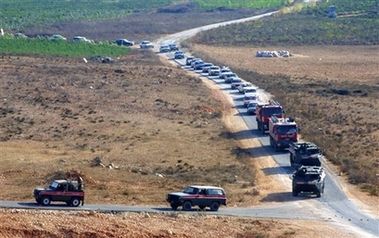 Anthony Shadid, Washington Post Foreign Service, Sunday, August 13, 2006; Page A01, HASBAYA, Lebanon, Aug. 12, Israeli troops entered Marjayoun at 3:30 a.m. Thursday. They had first seized Burj al-Molouk. Next was Qleia. The last, along a road stretching from the border, was the capital of the province, a faded, once-prosperous town that unfurls up a hill overlooking a valley carpeted in olive trees and the imposing, wizened peaks of Mount Hermon, known here as Jebel al-Sheikh."They came with the tanks, of course," said Fouad Hamra, the town's mayor.
Anthony Shadid, Washington Post Foreign Service, Sunday, August 13, 2006; Page A01, HASBAYA, Lebanon, Aug. 12, Israeli troops entered Marjayoun at 3:30 a.m. Thursday. They had first seized Burj al-Molouk. Next was Qleia. The last, along a road stretching from the border, was the capital of the province, a faded, once-prosperous town that unfurls up a hill overlooking a valley carpeted in olive trees and the imposing, wizened peaks of Mount Hermon, known here as Jebel al-Sheikh."They came with the tanks, of course," said Fouad Hamra, the town's mayor.
Residents said the 400 or so families in the town of Marjayoun stayed indoors, some too fearful to look out their windows to the street. Even a loud voice might draw notice, they said. The Israeli presence was ghostly -- some heard voices, a few saw the soldiers themselves, most knew of their presence by word of mouth, news broadcasts and the sound of fighting that went on outside their doors."People didn't dare leave their homes," said Hikmat Farha, a 53-year-old resident now staying in a Beirut suburb.Nearly everyone has now departed the Christian town, where houses of cream stone and red-tiled roofs sit tucked in a southern corner of Lebanon, perched unfortunately along the Israeli border. Some left in the early days of the month-long war, when Israeli forces laid siege to Khiam, a Shiite Muslim town across the valley, where fighting still raged Saturday. Most, like Hamra, left Friday in a harrowing convoy of hundreds of cars that plied a moonlit road and was attacked by Israeli aircraft. Six people were killed and more than 30 wounded
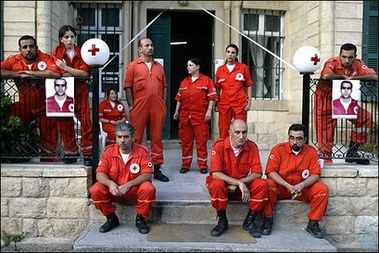 Michael Winfrey BEIRUT, Aug 13 (Reuters) - Relief agencies sent convoys towards southern Lebanon on Sunday, hoping a planned truce between Israel and Hizbollah guerrillas would mean rapid improvement in the humanitarian crisis there. Frustrated by heavy fighting and a ban on movement imposed by Israel's army, aid workers say they have been unable to bring food, water and medicine to an estimated 100,000 people trapped south of Lebanon's Litani River. But they said they could reach the area on short notice if a truce resulting from last week's U.N. Security Council resolution to end the war takes place on Monday as planned.
Michael Winfrey BEIRUT, Aug 13 (Reuters) - Relief agencies sent convoys towards southern Lebanon on Sunday, hoping a planned truce between Israel and Hizbollah guerrillas would mean rapid improvement in the humanitarian crisis there. Frustrated by heavy fighting and a ban on movement imposed by Israel's army, aid workers say they have been unable to bring food, water and medicine to an estimated 100,000 people trapped south of Lebanon's Litani River. But they said they could reach the area on short notice if a truce resulting from last week's U.N. Security Council resolution to end the war takes place on Monday as planned.
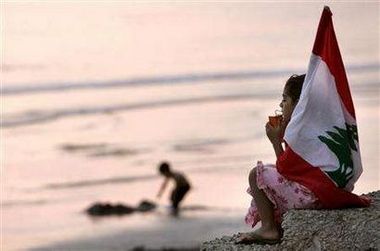 Published: Thursday, August 10, 2006, Sonia Verma reports from Beirut on how violence has caused thousands of young, university-educated professionals to leave Lebanon, possibly for good. BEIRUT - These are the trades 28-year-old Ziad Hawwa is willing to make to leave Lebanon: His swanky Beirut bachelor pad for an indefinite couch surf; the company of his elderly mother for a secure paycheque so he can support her from afar; his brand new Honda Civic for a one-way cab ride out of the country at a cost of $1,500."If I look to the future I see black," said Mr. Hawwa, nursing a bottle of mineral water in an eerily empty cafe near the pharmaceutical company where he still shows up for work in pressed khakis and a blue button-down shirt.
Published: Thursday, August 10, 2006, Sonia Verma reports from Beirut on how violence has caused thousands of young, university-educated professionals to leave Lebanon, possibly for good. BEIRUT - These are the trades 28-year-old Ziad Hawwa is willing to make to leave Lebanon: His swanky Beirut bachelor pad for an indefinite couch surf; the company of his elderly mother for a secure paycheque so he can support her from afar; his brand new Honda Civic for a one-way cab ride out of the country at a cost of $1,500."If I look to the future I see black," said Mr. Hawwa, nursing a bottle of mineral water in an eerily empty cafe near the pharmaceutical company where he still shows up for work in pressed khakis and a blue button-down shirt.
His friend, Nadia Khouri, a 32-year-old teacher whose salary has just been cut in half until further notice chimes in: "We have our whole lives ahead of us. We have to marry, find a house, make a family. We can't hope to do that here. Lebanon is dead," she said.Mr. Hawwa plans to catch a ride to Syria sometime next week. Ms. Khouri has already applied online for jobs teaching English in Dubai.
Estimates of the number of Lebanese nationals who have already fled to neighbouring Arab countries run upwards of 250,000 -- a staggering number in this nation of 3.5 million people.But as Lebanon reels from a month of punishing air strikes and braces for further fighting, government officials predict the exodus will swell to include hundreds of thousands more in the weeks and months to come.
August 10, 2006, AFP, MORE than 1000 civilians have been killed in Lebanon since Israel launched its massive offensive on July 12, …
Khazen History
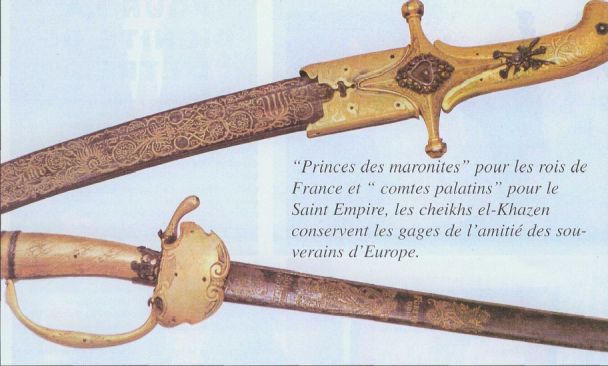

Historical Feature:
Churches and Monasteries of the Khazen family
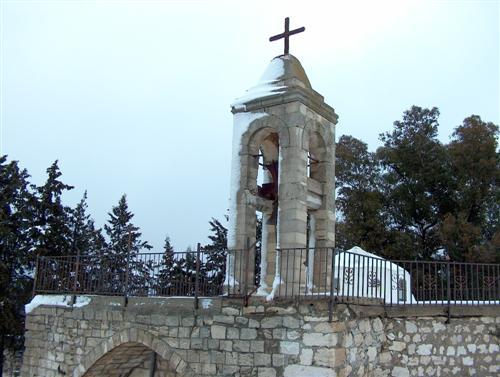
St. Anthony of Padua Church in Ballouneh
Mar Abda Church in Bakaatit Kanaan
Saint Michael Church in Bkaatouta
Saint Therese Church in Qolayaat
Saint Simeon Stylites (مار سمعان العامودي) Church In Ajaltoun
Virgin Mary Church (سيدة المعونات) in Sheilé
Assumption of Mary Church in Ballouneh
1 - The sword of the Maronite Prince
2 - LES KHAZEN CONSULS DE FRANCE
3 - LES MARONITES & LES KHAZEN
4 - LES MAAN & LES KHAZEN
5 - ORIGINE DE LA FAMILLE
Population Movements to Keserwan - The Khazens and The Maans
ما جاء عن الثورة في المقاطعة الكسروانية
ثورة أهالي كسروان على المشايخ الخوازنة وأسبابها
Origins of the "Prince of Maronite" Title
Growing diversity: the Khazin sheiks and the clergy in the first decades of the 18th century
Historical Members:
Barbar Beik El Khazen [English]
Patriach Toubia Kaiss El Khazen(Biography & Life Part1 Part2) (Arabic)
Patriach Youssef Dargham El Khazen (Cont'd)
Cheikh Bishara Jafal El Khazen
Patriarch Youssef Raji El Khazen
The Martyrs Cheikh Philippe & Cheikh Farid El Khazen
Cheikh Nawfal El Khazen (Consul De France)
Cheikh Hossun El Khazen (Consul De France)
Cheikh Abou-Nawfal El Khazen (Consul De France)
Cheikh Francis Abee Nader & his son Yousef
Cheikh Abou-Kanso El Khazen (Consul De France)
Cheikh Abou Nader El Khazen
Cheikh Chafic El Khazen
Cheikh Keserwan El Khazen
Cheikh Serhal El Khazen [English]
Cheikh Rafiq El Khazen [English]
Cheikh Hanna El Khazen
Cheikha Arzi El Khazen
Marie El Khazen